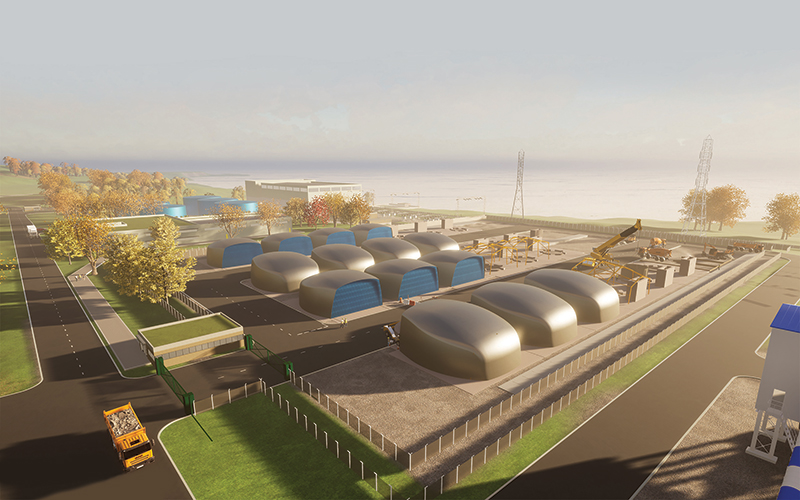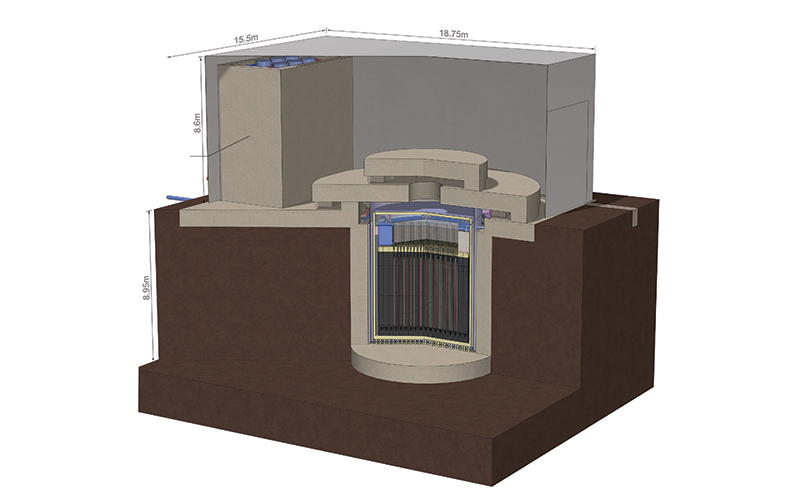The future is safer, cleaner, cheaper nuclear energy
Moltex’s Stable Salt Reactor will usher in a new age of clean, low-cost energy, says Chief Commercial Officer Simon Newton

Moltex’s UK team of scientists and engineers is focused on the complex challenge of delivering energy that is both clean and affordable, to address climate change.
The company’s answer is simple: Moltex has designed a nuclear reactor that uses the natural properties of materials so that the reaction happens in a controlled and safe manner. The reactor design uses standard materials, has no moving parts and is inherently safe. It is easy to build, install and operate, leading to lower costs than for coal, oil or gas.
The Stable Salt Reactor – Uranium (SSR-U) is a molten salt reactor, operating in the thermal spectrum and using low-enriched uranium (6%) in its fuel. Each reactor produces 40MW of thermal energy. This is enough to power a large town – but the reactors can be deployed in arrays on small sites, meeting the changing needs of growing urban centres. Unlike conventional reactors, the SSR-U’s output is dispatchable, which means that it can complement intermittent renewables, a role usually performed by fossil fuels.
By producing heat at 700°C, the SSR-U can also replace fossil fuels in industrial processes and produce clean, low-cost hydrogen via high-temperature electrolysis.

How does it work?
The SSR-U reactor differs from conventional designs in its concept, construction and operation.
Both the fuel and primary coolant in the SSR-U are molten salts. The fuel salt is contained in steel tubes, each of which is placed in a separate channel in a graphite matrix moderator, forming the reactor core. The core and primary heat exchangers are contained by the reactor tank vessel, which is filled with primary coolant. The vessel is placed in a concrete pit underground and covered with a concrete shield.
The initial fuel load remains in the reactor for 20 years (with two refuelling cycles over an expected reactor lifetime of 60 years). Natural convection through primary and secondary coolant loops removes the heat generated by the fuel. If for any reason this were to stop, the core would heat up – as with any nuclear reactor – but reactivity would decrease. So, unlike conventional reactor designs, the SSR-U requires no active systems or pumps for heat removal or shutdown.
In other molten salt reactor designs, where the salt acts both as fuel and coolant and is pumped through the system, corrosion is a major challenge. A unique feature of the Moltex design is that the fuel salt is separate from the coolant salt, allowing each to be tuned specifically for its task. By using different redox control mechanisms for each salt, Moltex can overcome these issues, even using standard steels to build its reactors.
SMR opportunities in Canada
Moltex Energy also has a Canadian subsidiary that is working on a 300 MW Stable Salt Reactor – Wasteburner (SSR-W) that is fuelled with recycled nuclear waste as well as a WAste To Stable Salt (WATSS) facility for recycling and thereby minimising nuclear waste. The Canadian federal government and the New Brunswick provincial government have both invested directly in the company, which is developing first-of-a-kind units for NB Power, and intends to build further units across the country and abroad.
Moltex’s laboratory in Warrington hosts a team of 20 physicists, chemists, metallurgists and engineers working on the supporting R&D. They are demonstrating the corrosion performance of the salts to be used in the SSR-U.
The SSR-U’s simple design, lack of moving parts, and inherent safety features translate into low capital costs. There is almost nothing for the operator to do other than defuel and refuel each reactor every two decades, making operational costs very low.
What will the SSR-U be used for?
From single units to large arrays, these devices will contribute to every aspect of decarbonisation across the economy:
- Clean electricity both on and off-grid
- Hydrogen as a direct fuel and through fuel cells
- Lower-emission heat to power industry
- Specialised applications such as marine propulsion and desalination.
Though energy production is the largest global economic activity, it also drives economic development. The global community faces the dilemma of reducing the use of fossil fuels while supporting the economic ambitions of a population that could reach 11 billion by 2100.
As the only way to answer both challenges is via cleaner energy production, the potential for the SSR-U is enormous. With its low cost, scalable configurations and high temperatures, it will suit any number of energy uses, for both developed and developing nations.
What’s next for the SSR-U?
While Moltex’s development activity continues, the company is now making the technology public and beginning the process of seeking the right jurisdiction in which to license and build the first plants.
With the release of its energy strategy, the UK government is demonstrating a renewed focus on nuclear power, with a desire for 25GW or more by 2050. Moltex is keen to make the most of this newfound enthusiasm. The support required is not financial: this is a small reactor that can easily be financed by private equity.
Moltex needs governments to provide access to the regulator, suitable sites and a licensing and consenting regime that is proportional in terms of costs and timescales. With the right support, it will be possible to implement the first reactor by the end of the decade and deploy a fleet during the mid-2030s.
By Simon Newton, Chief Commercial Officer, Moltex Energy
Image credit | Moltex






Follow us
Advertise
Free e-Newsletter